 |
| Overview Map |
Early in the morning of
27 July 1942, all deportees were separated into two groups.
The larger group, consisting of those to be deported to
Belzec were herded
to the deportation square, an open field called
"Smietnisko" ("the dump")
surrounded by a wire fence, and situated near
Iwaszkiewicza Street. The elderly,
the sick and children accompanied by their grandparents were kept in another place near
Mikolaja Street. The main group was marched
to the railway station in the evening. The elderly were carried in trucks, throughout the day,
to the execution site in the forest near Grochowce village. This procedure was repeated
on
31 July and 3 August.
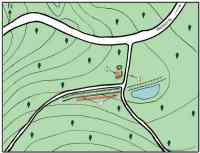 |
| Map of the Killing Site |
The exact number of those executed is not known. Some sources propose a figure as
high as 4,000; most others suggest 2,500. Witnesses speak of 3 graves (two large pits
and one small pit). Only one of these pits was found in
1958, from which the remains of
532 victims were exhumed and reburied in
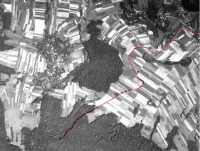 |
| Aerial Map |
the
Jewish cemetery.
The exhumation works
were discontinued. The place in the forest remained unmarked until
2002, when a group
of researchers found the evidence of the crime and the location of one of the graves.
There were no signs of the burning of remains at the site.
The Grochowce massacre and the events in the ghetto that preceded it are mentioned in several testimonies:
Klara Pfeffer’s letter to
Wiktor Reisner,
in
1946:
"
We were concerned about the old folks, i.e. your mother and my parents and sister.
It was a terrible night. The unfortunate ones were distraught, yet brave. They were counting
on the fact that they were going to suffer and to do hard labour – but that they would, after all,
return. The older folks might have had other feelings – I even recall that your Mom (Joanna
Thürhaus-Reisner – ed.) told me with
sarcasm that they were going "auf eine Landpartie",
that is, that she understood that this tragedy would end in the countryside ..."
Testimony of
Bernard Ekert:
" ...
On 28 July (actually 27 July – ed.)
1942, the day of the first operation in the
Przemysl ghetto, I saw out my window on Boguslawskiego
Street how thousands of unfortunates sat in rows on the filthy square known as "the dump" which had been
designated as the gathering place for the Jews who were to be transported, as it turned out, to
Belzec. The older Jews were chased by the Gestapo with whips into trucks
and taken to Grochowce where they were killed ..."
Testimony of
Krystyna Krolik:
" ...
On 30 June (actually 27 July – ed.)
1942, the square was packed. Each person took five
kilos of baggage. Trucks arrived, onto which the packages were loaded. The people sat there;
they weren’t allowed to stand or move around or talk. They were ordered to surrender their
valuables, dollars. People tore up their cash and buried their valuables as they sat there.
Each time a group left the square, the order was given to dig up (the area where they had
sat – tr.) and, of course, valuables were found. This despite the fact that burying them
or moving at all would be punished with a bullet..."
Klara Pfeffer’s letter to
Wiktor Reisner,
in
1946:
" ...
I was unconscious from pain and anguish. Towards evening, I was brought a
card about their hunger from the square where those poor people
were standing; I keep that card as a relic. Of course, I ran like a woman possessed to give them what they had
asked for. Unfortunately, I could see them from afar, already walking two by two to the station ...
I never saw them again..."
Sefer Przemysl - Przemysl Memorial Book:
" ...
The people gathered in the deportation square. Disabled, elderly, and sick people,
who could not walk and had to be carried from their homes on stretchers, were taken to
a small square in the ghetto and shot. Among these people were Mr. Laub, and
Lette the seamstress. Dr Grabscheid, the
eldest doctor, whom they tried to lead to this square, knew what would happen to him there and so he tried to protest
the order and announced that he was strong enough to travel with the deportees in the eastbound transport.
He was then led along with the others in trucks to Grochowce, where they were all killed.
Afterwards, the Gestapo took all their families to the deportation square, when the first
transport had left for the train, and shot them there. There was one sick woman who
came with a child in her arms. She was shot and the child was killed by a Gestapo man,
who took him by one leg and smashed his head against the wall..."
Testimony of
Markus Hand:
" ...
The elderly and handicapped were taken in trucks to the
Zniesienie suburb
and shot there into a mass grave. The rest were loaded, one hundred to a truck, and taken off in the direction of
the extermination station Belzec. We never heard anything of those people
again..."
Klara Pfeffer’s letter to
Wiktor Reisner,
in
1946:
"
After the operation, quite a bit later actually, I found out that the old folks had been loaded
onto trucks on Mikolaja Square in a frightful and brutal fashion and taken away
to Grochowce where they were shot, naked, and buried half-alive in pits. The younger people were taken
away in crowded, sealed rail cars to Belzec, where they perished in the gas
chambers..."
Testimony of
Markus Hand:
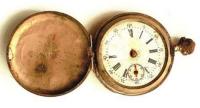 |
Golden Watch, found at
the Killing Site |
" ...
The mass graves were prepared by the workers of the Polish
Baudienst, who were also present at the execution. They robbed all the people awaiting their
death and hurried them into entering the graves. The Baudienst was an obligatory service for Poles
aged 21 – 22. They wore German work force uniforms and were under German RAD (Reichsarbeitsdienst)
command. It was from them that we found out what had happened at
Zniesienie. Some of them boasted of what they did,
some of them were ashamed when they talked about it. The poor, doomed people were ordered to stand
at the edge of the grave, facing towards the grave and they were murdered from behind with a shot to the
skull, so that they would fall into the grave themselves. Then the Baudienst workers would cover
each layer of bodies with a layer of lime. After each layer of lime there would be another layer of bodies.
Those who resisted would be beaten into entering the grave quickly. Before each execution, the doomed
ones would have to undress and fold their clothes. The clothing could contain valuables and, in any
case, it was destined for the German market..."
Diary of
Rafal Wozniak, priest:
"
29 July. During the night we heard gun and
machine-gun shots nearby. The Germans were
shooting Jews, who tried to escape from the ghetto. In the morning we found out that 7
Jews were shot near our shops. We saw bloodstains. From this moment the real persecution of the
Jews started. Trucks were coming and taking as many Jews as possible, carrying them beyond
the cemetery and there mercilessly shooting them in the back of the head. Polish boys,
so-called "junacy" (members of young men’s labour brigade – Baudienst – ed.), helped them.
They were given vodka to pep them up. Thousands of Jews were shot, thousands more
were carried to Belzec and burned there."
Joseph Rebhun, "Leap to Life":
"
The old ones, the sick, and some children were taken by trucks to the outskirts of the city,
to Zniesienie. Here they were shot. The dead and those still living were
thrown into prepared graves by Polish and Ukrainian members of the work units, Baudienst. The Germans had
given these workers vodka beforehand to numb their human feelings. Some boys from the
Baudienst were assigned to extract any gold teeth or teeth with gold fillings and to remove
rings from those who still had them. Then the Baudienst covered the graves with soil, still
wet-brown from all the blood. And the earth moved. For several days afterwards, a few of the
boys were sick, and the news of the killings spread from the physicians who attended to them."
Testimony of
Markus Hand:
" ...
A certain segment of the Jews, no more than a few hundred, hid out rather than being
deported. From time to time, you’d see some old lady or a middle-aged woman on the streets.
The Germans therefore called for a registration of these people, so that they could be put to
work and so that they could be issued identity papers that would permit them to live in the
district. Most importantly, they received work cards with a special square stamp. No one was
given a hard time at registration; people were even allowed to work for one day. However,
already on the second day, when everyone – calmed about their fate by the promise of work –
went to work, the Germans loaded them onto trucks and took them to Zniesienie
where they were would rest alongside the victims of the first Aktion."
It needs to be pointed out that whenever witnesses speak of "
Zniesienie"
and "
Zielonka", this most probably signifies the Grochowce forest where in fact
the road leads through these places. The witnesses could not have known whether the trucks carrying the condemned
would stop at the Jewish cemetery on
Slowackiego Street, where mass murders were
also committed, or go further on to the forest.
Testimony of
Emil Sawicki, born in
1932, living in
Kruhel Wielki:
"
In 1942, I was ten and I remember that once, when I
was playing with my friends, I saw German
trucks going from Zielonka to the
Grochowce woods. Each day, there would be twenty or thirty
of them. Each one was covered with a tarpaulin and Germans in steel-gray uniforms and holding
machine guns sat at the back. We heard shots from the woods and, ignoring the danger – boys
are curious about everything – we crawled through the bushes, right near the place. Maybe fifty
meters away. I saw people completely undressing next to a pit. There were stairs leading into the
pit and the people had to walk down them. Then they’d be killed with a volley. At the opening
of the pit, there stood a machine gun on a tripod and near the oak – only the stump is still there
now – there were cases of vodka. I heard loud screams. Mostly women screamed. Then there
were single shots and a moment of silence until they brought the next ones. I saw how, during the
breaks, they’d drink vodka from bottles, just like construction workers. Each truck would
bring thirty or forty people. The things they left behind were loaded on to the trucks by the
Ukrainian guards; they would also cover the bodies after each round with earth and lime.
I was a kid and didn’t think about it, but it was shocking. Then my father told me I couldn’t
go there, but you could still hear the shots, groans and screams from our house, which was
less than half a kilometer from there. Later, when the Germans began preparing to retreat,
they brought some heavy equipment there which droned on for two weeks. I guess they were
destroying the evidence. After the war, in 1963
(actually 1958 – ed.),
an exhumation was done there, but in a very cursory way, since someone apparently told them not to do any more for
health reasons."
Testimony recorded on
3 February 2002, by
Jacek Szwic.
Testimony of
Piotr Bienko, born in
1922, living
in Grochowce:
"
... I was drafted to Baudienst in April 1942.
We were quartered in the former Jewish dormitory at Leszczynskiego Street.
There were two detachments, one of 120 men and another of 70 men...
I was in Baudienst for 9 months. In June we were fencing off the ghetto at
Czarnieckiego Street with poles and barbed wire. On one of the Sundays we
were taken in trucks out of town to Zielonka and then, by foot to the forest.
On the second bend of the forest road we were directed into the forest, and some 50 m from the road we were divided
into groups and ordered to dig pits. 3 graves were dug, 50 m long, 2 m wide and 2,5 m deep. In some places it wasn’t
possible do dig that deep, because of rocks and stones. Later we heard that Jews were executed there.
The Germans completely filled two of the graves and one only partially, because they were already drunk and a lot
of Jews escaped. After a week or two I was there once again. We were camouflaging it. There were no signs of the
shooting. Germans brought turf to cover (the pits – ed.) and erase all evidence. They intended to plant some
firtrees, but it was summer, hot, and and the trees dried up. Later some other grass grew there. Afterwards, I
heard that at this job, at the shooting, the Ukrainian detachment (of Baudienst – ed.) was present.
They were quartered at Tarnawskiego Street and they were taken to
help with the shooting. They said that a lot of young people escaped, only elderly and children remained. The third
grave was not filled, only two graves were full. And there were no traces left. Probably Germans themselves took
all the rugs and the other possessions. In order to erase all evidence..."
Testimony recorded on
5 April 2001, by
Jacek Szwic
 |
| Witnesses |
Testimony of
Stanislaw Gieron, born in
1922, living in
Kruhel Wielki, an eyewitness to the execution of the Jews in the Grochowce
woods in
July 1942:
"
In 1942, in April, they took me to the construction corps
(Baudienst) and we were put
up in the old Jewish dormitory in Bakonczyce. We worked dismantling the railroad
tracks in Bakonczyce. I was in the eleventh group; they dressed us in blue denim
overalls and berets with a triangular badge. In July, on some Monday, they gave us
shovels – which was strange, since we didn’t use shovels for the track work.
A big truck arrived and we were loaded on board and taken through Zielonka
to the Grochowce woods. There were twenty of us. We were really afraid that they might shoot us, but our foreman
calmed us down, saying they were going to shoot Jews and he told us to dig a pit. We spent three
days digging four trenches, each fifty meters long, two meters wide and two and a half deep. It
was hard digging, because the soil was rocky and full of roots and it was hard to cut them with
army axes. On Thursday, they began to bring the Jews in. When a truck came, the women,
children and older people had to get down and get undressed. Some of them had money and tore
it up, but a German watched for that and beat people for that. They had to put all their things in a
pile about fifteen meters from the pit. The pit had stairs at one end and they’d take them down the
stairs in groups of nine. First, we were ordered to make a kind of brace out of sticks and, when
the Jews reached the end of the pit, the officer would yell "Fire!" and they’d lean their machine
guns on that brace and fire volleys into the pit.
The people there would scream and cry, a few fell down dead right away and others who were
wounded would scream. The ones who went down into the pit had to lie out the dead neatly.
It was a terrible sight, blood everywhere, and terrible groans and then they’d bring in the next
ones right away. I saw how one woman fell down dead and there was a child under her who
wasn’t even scratched. It was a boy, maybe he was four years old. He screamed "Mama, Mama!"
and cried. A German ordered me to go into the pit and bring the boy out. He sat down
under a tree and cried terribly. I thought for a second that the boy would be spared, but the
German just took him by the hand, walked him into the pit and killed him with one blow of his
rifle butt to the head. When one layer of corpses was completed, they’d order us to cover them
lightly with earth and lime, a pile of which was lying by the road. Then they’d bring the next ones
and, when nine layers filled the pit, they’d fill in that pit and go to the next one.
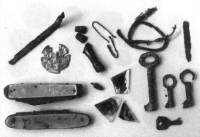 |
| Evidence |
This went on three days. I don’t know how many they killed, but there were thousands. In the
end, they only brought a few, those who had been hiding in the ghetto. I remember how one
jumped from the truck at the very edge of the forest. The Germans shot at him till they killed him.
Wacek Ulanowski from Kruhel and I had to bury
him right away out by the World War I border stone. A drunken German supervised us and I was afraid he’d kill us.
After it was all over, they took us – only ten of us this time – and told us to even out the ground and cover up
the signs (of digging). Then they took us to dig a pit by the wall of the Jewish cemetery on
Slowackiego Street.
We dug along the wall from the Pikulice side and then we buried those
who had been captured in the ghetto. Their things were taken to a warehouse on
Mnisza Street. I know that because they ordered us to unload the truck and then
I found out what was there. Later, people said that the Germans, before they pulled out, took some kind of units to
the woods, probably to burn the bones and cover up the evidence. I think I could probably still find the place."
Testimony based on a tape-recording made by
Jacek Szwic of his conversation with
Stanislaw Gieron on
10 July 2002.
Sefer Przemysl - Przemysl Memorial Book:
" ...
According to recently discovered information, 6,000 bodies of
Przemysl
Jews killed in Bircza, Kunkowce, Lubaczow and Grochowce were transferred in
1957 to the Przemysl cemetery, as decreed by the
government and with its financial aid. Each group was buried separately in a mass grave, and the tombstones
were engraved with the location of the murder and the number of victims..."
Testimony of
Adam Dorociak (born in
1909, living
in
Przemysl):
"
I don’t exactly remember the date, at any rate some time
after 1950 I took part in work
connected with the exhumation of corpses in the Grochowce forest under the control
of the Regional Health and Epidemiology Centre. My function was to make sure that the
workers exhuming the remains of those shot and buried abided by health regulations
and disinfected whatever was unearthed. The exhumation was carried out in the place
pointed out by a person whose name I’ve now forgotten. He was once a member of the
Baudienst, and after the Jews had been shot by the German police, had buried the
corpses of those shot. As far as I can remember it was a large collective mass grave
between the trees. This place was made level with its surroundings and was overgrown
with grass and small bushes. Only parts of skeletons, skulls and thighbones remained
of those shot and buried. I saw skulls that were damaged as a result of bullets from a firearm.
Today, because of the length of time that has passed I am unable to describe the number of
skeletons retrieved from the grave. At any rate, there were several hundred. I also
recall that they looked for a second mass grave but that it wasn’t found."
Report of the Institute of National Remembrance in
Rzeszow,
on
11 May 1974.
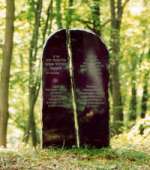 |
| Matzevah |
Tourist map of
Podgorze Przemyskie,
Rzeszow 1991:
"Grochowce – a medieval village. In
1656,
Stefan
Czarniecki issued his
manifesto here, calling upon the peasants to rise up against the Swedish invader. In the forest known
as
Iwanowa Gora, one can find the site of a mass execution of Jews
(approx. 4,000 people) during the occupation. This site is marked with a monument ..."
In reality the monument had existed only on maps. After three years of searching and investigation
of the surrounding area, the researchers were able to precisely locate the place of execution.
As a result of the efforts of the families of those murdered and a group of citizens from
Przemysl, in
July 2002 on the 60th anniversary
of this heinous crime, this place was commemorated for the first time with the placing of stones
with a Polish and Hebrew inscription:
"O Earth cover not thou my blood, and let my cry have no rest." (Job 16.18)
The execution site in the Grochowce forest was one of literally hundreds of such places throughout Poland and the
former Soviet Union. Some claimed more victims, some fewer.
The precise location of many of these sites is still unknown, and only few of them are marked or carry any kind
of memorial. It is only due to the efforts of a small number of individuals, dedicated to preserving the memory
of these events, that the information set out above has been collated.
May this record of one site of mass murder serve as a memorial for all of the countless similar places where no
such detailed research has yet been possible.
Sources:
1. Irgun Yotzei Przemysl,
Sefer Przemysl (Przemysl Memorial Book), Tel Aviv 1964 (English translation
by JewishGen Inc.)
2. Relacje collection of the Jewish Historical Institute in Warsaw
3. Wozniak R. OFM,
Przemysl w latach II wojny Swiatowej, Poludniowo-Wschodni Instytut Naukowy, Przemysl 1998
4. Rebhun J.,
Leap to Life, Ars Scribendi, New York 2002
5. Biedka L., Szwic J., Szwic P., (English translation by R. Reisner, Y. Reisner)
Pamiec / Memory,
San Set, Przemysl 2002
© ARC 2005















